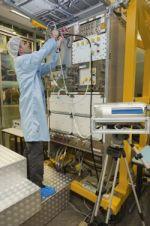 The Dutch ESA astronaut André Kuipers will likely remain in contact with this operations centre during his second space journey (mission) in 2012. USOC is a high-tech ‘ground control’ for space missions. Shots from various camera angles, large video screens show the activities unfolding onboard the ISS, where the astronauts are at work as travelling scientists. A second screen shows the space station as it orbits the Earth. Moreover, various computer links allow scientists from across Europe to communicate with those onboard and to study test results and help solve problems. A special link ensures that the experimental data arrives at the USOC and can then be relayed to a scientist’s ‘home base’.
The Dutch ESA astronaut André Kuipers will likely remain in contact with this operations centre during his second space journey (mission) in 2012. USOC is a high-tech ‘ground control’ for space missions. Shots from various camera angles, large video screens show the activities unfolding onboard the ISS, where the astronauts are at work as travelling scientists. A second screen shows the space station as it orbits the Earth. Moreover, various computer links allow scientists from across Europe to communicate with those onboard and to study test results and help solve problems. A special link ensures that the experimental data arrives at the USOC and can then be relayed to a scientist’s ‘home base’.
Seven NLR specialists will man the USOC, if necessary 24 hours per day, offering assistance to the astronauts as they conduct their scientific experiments. Starting in December, the Italian ESA astronaut, Paolo Nespoli, will conduct such experiments on board the space station.
The NLR specialists manning the USOC were involved in developing this operations centre from its very conception. They are now preparing the payload operations and will conduct these operations once the facilities are brought on board and the operations planned. This can involve all types of experiments, ranging from materials research and protein crystallization to various biological experiments. The NLR specialists are also responsible for the maintenance of all ground systems.
The NLR personnel at the USOC are capable of assuming all these responsibilities thanks to their years of experience in the field of payload operations, which began some 20 years ago but has intensified since the launch of the European space lab, Columbus, in 2008. The NLR’s USOC operators have been certified by NASA. ‘It is not something you can learn in a short course,’says a NLR spokesperson.
The experiments that will be lead from the USOC are those from the European Drawer Rack (EDR) and the European Technology Exposure Facility (EuTEF). EDR is a flexible, experimental workbench for various scientific disciplines on board the Columbus. EuTEF is an experimental module that was attached to the outside of the ISS’s Columbus and allows for research of cosmic rays, for example. The USOC leads the processing of the results of EuTEF experiments, which last year were brought back to Earth by the Space Shuttle. In future it is hoped that USOC will also help prepare new EuTEF experiments. The Dutch Ministry of Economic Affairs allocated the funding to ESA/ESTEC, which in turn extended a contract to NLR for carrying out the operations.
In addition to Hans de Groene, the Ministry of Economic Affairs’ director general, Simonetta Di Pippo, ESA’s director of Human Space Flight, was also present at the contract signing: ‘USOC’s are vitally important for gaining the best results from European scientific experiments on board the ISS. This contribution from the Dutch government puts us in a better position to serve science with space research.Â


